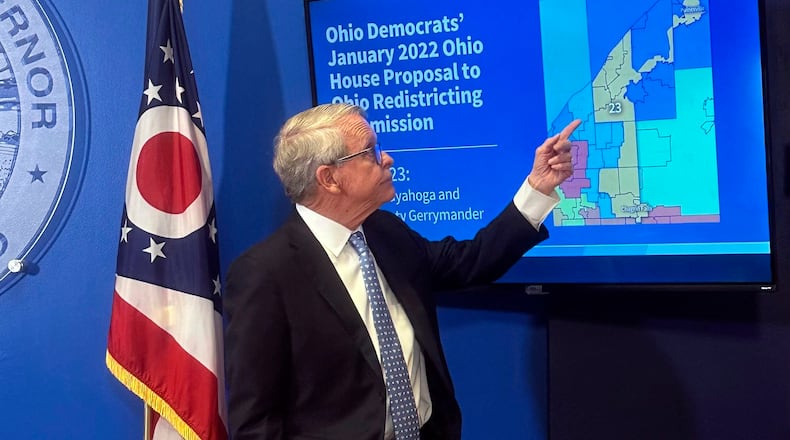In Ohio, proportionality would mean that the state legislature should consist of just over half of districts favoring Republicans and just under half of districts favoring Democrats, given recent voting patterns that slightly favor Republican candidates in Ohio’s statewide elections.
But DeWine said it’s an idea that poisons the well. He argued that it incentivizes and even mandates map drawers — whether they’re politicians or citizens — to cut up cities, counties, school districts and neighborhoods into different districts in order to achieve a political end.
“Using proportionality as your guiding north star means your map will divide communities of interest. They will tear up counties, tear up cities, tear up villages and school districts,” DeWine said, which he reasoned would disillusion voters even more than they currently are.
Once he laid bare his concerns, this news outlet asked DeWine if he had any optimism that November’s amendment would produce good results for Ohio.
“No. No way in hell,” DeWine responded. “There’s no way you could follow the Constitution and not have these horrible maps.”
The governor’s position comes weeks after the state officially certified Citizens Not Politicians’ amendment onto the November ballot. That amendment seeks to overhaul the way state legislative and congressional districts are drawn here in Ohio, in part by enforcing different rules for map drawers but also by changing who draws and approves the maps.
If supported by a simple majority of voters, this November’s amendment would do away with the Ohio Redistricting Commission (only used twice and made up of five Republicans, including DeWine, and two Democrats) and replace it with a 15-member Citizen Redistricting Commission that consists of five Republicans, five Democrats, and five independent voters with no ties to politicians.
The initiative’s call for proportionality is not new, nor is it hugely different from Ohio’s current system.
The proposed amendment reads that it would decipher what the proportions ought to be by looking back at the past six years of voting data and ensure that the partisan lean of the maps “correspond closely,” which in this case means within 3%. Ohio’s current system has a 10-year look back period and also requires that the maps “correspond closely,” though the limits aren’t defined.
The public face of the group is retired Ohio Supreme Court Chief Justice Maureen O’Connor, a lifelong Republican who joined her Democratic colleagues seven times in shooting down state legislative and congressional maps that were passed by DeWine and various Republicans on the Ohio Redistricting Commission because the maps lacked proportionality.
In a statement, O’Connor accused the governor of spreading misinformation about the amendment and called his framing of the amendment offensive to the Ohioans that want reform. “Since the Governor demonstrated in his rambling and disjointed press conference today that he does not understand our amendment,” she wrote, “I am offering to sit down and meet with him to explain it.”
Chris Davey, a spokesperson for Citizens Not Politicians, told this news outlet that the organization refutes DeWine’s claim that proportionality is king in the proposed amendment.
Davey said the amendment requires that Ohio’s maps comply with the U.S. Constitution as well as the Voting Rights Act and contains clear provisions against unfairly benefiting a political party.
“Those are very important guardrails — guardrails that have already been supported by Ohio voters, but were then repeatedly and flagrantly ignored by politicians — and they don’t require any of the specific targets or maps that the Governor represented,” Davey said.
House Minority Leader Allison Russo, D-Upper Arlington, posted on X that the governor’s press conference made it clear that “DeWine and other GOP politicians are scared silly of the full power of Ohio voters.”
Meanwhile, House Speaker Jason Stephens, R-Kitts Hill, said in a statement that he supports DeWine’s position.
“We have less than 100 days to unite and show voters why Issue 1 is bad for Ohio,” Stephens wrote. “I look forward to working with the Governor, the Senate, and the entire GOP Caucus to defeat Issue 1 in November.”
Despite DeWine’s strong opposition to November’s ballot initiative, he did not advocate for the state to stick to the status quo. In fact, he said his personal experience with the system — as the only Ohio governor to participate in it — led him to conclude “it simply does not work very well. It needs to be changed.”
DeWine said politicians shouldn’t be in charge of drawing the lines, but also that proportionality and partisan voting patterns should not be considered by map drawers at all — a lesson he learned over the past four years as the state struggled to produce maps that prioritized keeping communities whole while also conforming to the proportionality requirement.
“Maps should be drawn based on population with no consideration of past partisan voting patterns,” DeWine said, “and the maps should try to avoid the splitting of political subdivisions of cities or counties or villages and our townships.”
DeWine told reporters that he will ask the Ohio Legislature to create a redistricting plan that is similar to the state of Iowa’s, which for forty years has banned its map drawers from looking at voter data and instead requires them to solely rely on the data of the latest census. DeWine said he wants to have full hearings on the plan in the legislature and then put it on a ballot for voters to approve or disapprove in 2025.
“Here’s what I’m doing today,” DeWine told reporters. “I’m starting this debate. I’m starting this discussion. This is a discussion we need to have.”
For more stories like this, sign up for our Ohio Politics newsletter. It’s free, curated, and delivered straight to your inbox every Thursday evening.
Avery Kreemer can be reached at 614-981-1422, on X, via email, or you can drop him a comment/tip with the survey below.
About the Author

